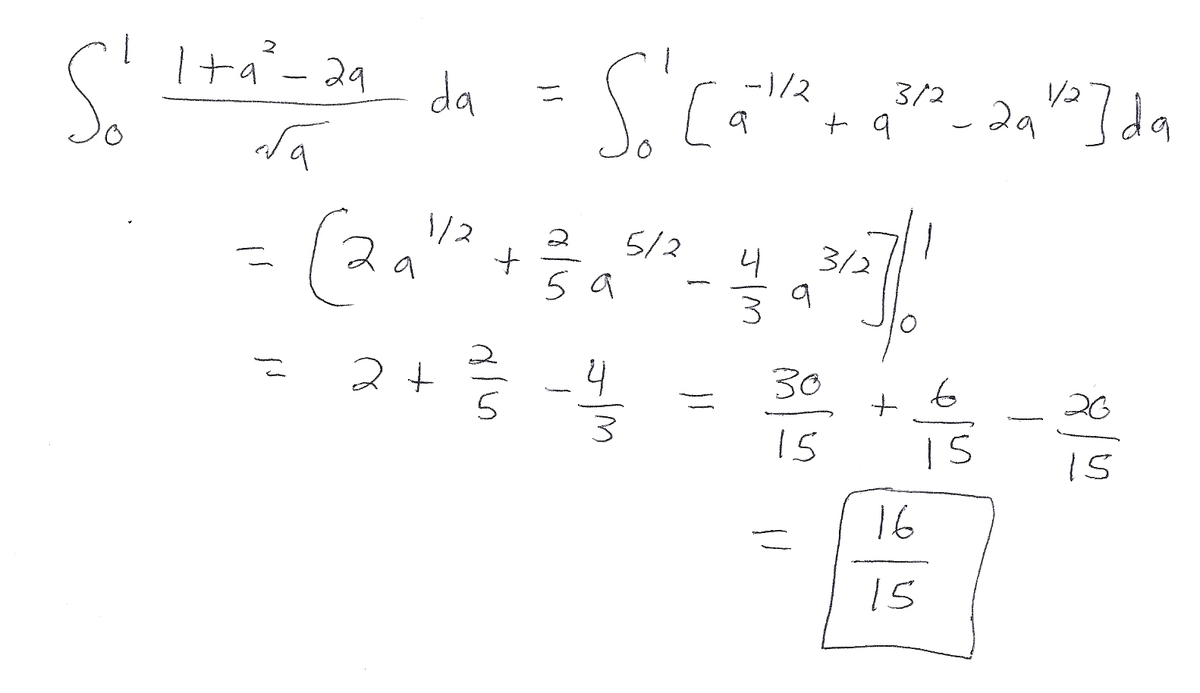Calculus 4: Function
∫ 0 1 a 1 + a 2 − 2 a d a
If value of the above integral is of the form B A , where A and B are coprime positive integers, find the value of A − B .
The answer is 1.
This section requires Javascript.
You are seeing this because something didn't load right. We suggest you, (a) try
refreshing the page, (b) enabling javascript if it is disabled on your browser and,
finally, (c)
loading the
non-javascript version of this page
. We're sorry about the hassle.
3 solutions
There is a simpler way. Just use u-substitution.
Log in to reply
Yeah I saw other solutions but this problem is actually based on beta function, so my solution solves it that way
Log in to reply
It is better to show others the easiest way to solve a problem.
I = ∫ 0 1 x 1 + x 2 − 2 x d x = ∫ 0 1 x ( x − 1 ) 2 d x = ∫ 0 1 u 2 u ( u 2 − 1 ) 2 d u = ∫ 0 1 2 ( u 2 − 1 ) 2 d u = 2 ∫ 0 1 ( u 4 − 2 u 2 + 1 ) d u = 2 ( 5 1 − 3 2 + 1 ) = 1 5 1 6 Let u 2 = x , 2 u d u = d x
⟹ A − B = 1 6 − 1 5 = 1
It's also possible to do this in a very pedestrian way.

Relevant wiki: Beta Function
I = ∫ 0 1 a 1 + a 2 − 2 a d a = ∫ 0 1 a − 2 1 ⋅ ( 1 − a ) 2 rewrite the integral = ∫ 0 1 a 2 1 − 1 ⋅ ( 1 − a ) 3 − 1 = ∫ 0 1 a p − 1 ⋅ ( 1 − a ) q − 1 where p = 2 1 and q = 3 Now, the above is of the form : ∫ 0 1 t y − 1 ( 1 − t ) x − 1 d t Therefore, ∫ 0 1 t y − 1 ( 1 − t ) x − 1 d t = B ( x , y ) ; B(x, y) represents Beta function ∴ I = B ( p , q ) = B ( 2 1 , 3 ) I = Γ ( p + q ) Γ ( p ) Γ ( q ) = Γ ( 2 1 + 3 ) Γ ( 2 1 ) Γ ( 3 ) = Γ ( 2 7 ) Γ ( 2 1 ) Γ ( 3 ) = 8 1 5 π π ⋅ 2 = 1 5 1 6 = B A ∴ A − B = 1 6 − 1 5 = 1
___________________________________________________________________________________
Now, finding values of Gamma functions.
Γ ( 2 1 ) = ∫ t = 0 + ∞ t 2 1 − 1 e − t d t = ∫ t = 0 + ∞ t e − t d t , y = t ; d y = 2 t d t Γ ( 2 1 ) = 2 ∫ y = 0 + ∞ e − y 2 d y = ∫ y = − ∞ + ∞ e − y 2 d y = π . Γ ( x + 1 ) = x Γ ( x ) For x = 2 5 Γ ( 2 7 ) = 2 5 Γ ( 2 5 ) For x = 3 Γ ( 2 5 ) = 2 3 Γ ( 2 3 ) Γ ( 2 n ) = 2 2 ( n − 1 ) ( n − 2 ) ! ! π Γ ( 2 3 ) = 2 2 ( 2 ) ( 1 ) ! ! π = 2 π ∴ Γ ( 2 5 ) = 2 3 Γ ( 2 3 ) = 4 3 π ∴ Γ ( 2 7 ) = 2 5 2 5 Γ ( 2 5 ) = 2 5 ⋅ 4 3 π = 8 1 5 π